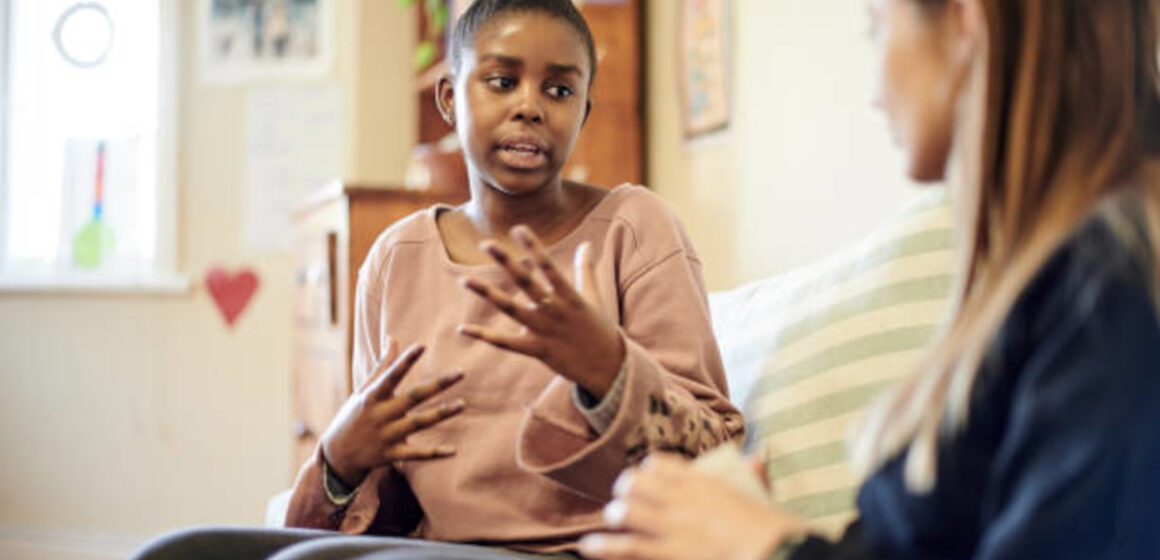Effective Strategies for Helping Adolescent Clients with Body Dysmorphic Disorder
Are you worried about constant negative thoughts about your appearance? Body Dysmorphic Disorder (BDD) affects 1 in 50 people, including many adolescents. This article will guide you through understanding BDD in teens and offer effective strategies for managing it.
Keep reading to learn more.
Key Takeaways
- Body Dysmorphic Disorder affects many adolescents, making them obsess over small or imagined flaws in their appearance. This can lead to severe distress, social withdrawal, and even thoughts of suicide.
- Treatment options like Cognitive – Behavioral Therapy (CBT) and medications such as SSRIs are effective in helping teens manage their symptoms. These approaches focus on changing negative thought patterns and addressing the obsessive behaviors linked to BDD.
- Cultural influences play a significant role in shaping how adolescents perceive themselves. Different societies have varying beauty standards that can impact teenagers’ body image concerns and risk for developing BDD.
- Recognizing the signs of Body Dysmorphic Disorder early is crucial for effective treatment. Symptoms include excessive mirror checking, avoidance of social situations, and extreme distress about one’s appearance.
- Lifestyle changes and home remedies like practicing mindfulness, engaging in physical activity, limiting mirror checking and social media use can support adolescents with BDD alongside professional therapy treatments.
Understanding Body Dysmorphic Disorder in Adolescents
Body Dysmorphic Disorder (BDD) grips many adolescents with a distorted view of their appearance, often overshadowing their perception of reality. This mental health condition triggers an obsessive focus on perceived flaws, significantly impacting teenagers’ lives and well-being.
Clinical Characteristics of Body Dysmorphic Disorder
Body Dysmorphic Disorder (BDD) affects individuals by causing a persistent and intrusive preoccupation with one or more perceived flaws in their appearance, which are not observable or appear slight to others.
This mental health condition triggers significant emotional distress and can dominate a person’s thoughts for hours each day, leading to intense shame, anxiety, and in severe cases, suicidal ideation.
People with BDD frequently engage in repetitive behaviors such as mirror checking, excessive grooming, skin picking, or seeking reassurance about their looks from others in an attempt to alleviate their distress.
These compulsive actions often result in functional impairment across various aspects of life including social isolation due to heightened self-consciousness and avoidance of social situations where the perceived flaw might be noticed by others.
Despite these challenges, individuals may resist seeking help because of embarrassment or the mistaken belief that their concerns are superficial or not genuine mental health issues.
The link between BDD and other disorders like obsessive-compulsive disorder (OCD), eating disorders, and major depressive disorder highlights the necessity for professional diagnosis and treatment intervention tailored specifically for those experiencing body dysmorphia symptoms.
Moving forward into understanding the prevalence of Body Dysmorphic Disorder will provide further insight into its impact on populations worldwide.
Prevalence of Body Dysmorphic Disorder
Body Dysmorphic Disorder (BDD) affects a significant portion of adolescents around the globe. Studies show that approximately 2% to 3% of the general population suffers from this condition, but among teenagers, these numbers can be even higher due to increased vulnerability related to self-image and peer comparison during adolescence.
This disorder knows no borders, impacting individuals across different cultures and backgrounds.
Adolescents with BDD often experience intense distress over perceived flaws in their appearance, which might not be noticeable or seem minor to others. These persistent worries about appearance can lead them into cycles of compulsive behaviors, such as excessive mirror checking or grooming, and avoidance tactics like dodging social events or photos.
Such actions interfere with daily life activities and contribute significantly to mental health conditions like anxiety disorder and depression among youth. Recognizing the prevalence of BDD is crucial for early intervention and support for affected teens.
Cultural Considerations
Moving from the prevalence of Body Dysmorphic Disorder, it’s crucial to explore how culture plays a significant role in shaping perceptions and experiences of this condition. Different societies have unique beauty standards that can influence individuals’ body image concerns.
These varying ideals may heighten the risk for developing symptoms related to Body Dysmorphic Disorder among adolescents who feel pressured to meet such expectations.
Cultural beliefs and values impact how symptoms are expressed and understood by those suffering from Body Dysmorphic Disorder. For instance, in cultures where high value is placed on physical appearance, individuals might experience more intense feelings of shame or embarrassment about their looks.
This cultural emphasis can also affect coping strategies, leading some adolescents to seek cosmetic procedures as a solution for their distress, despite potential risks and the advice of mental health professionals.
Identifying Body Dysmorphic Disorder in Youth
Spotting Body Dysmorphic Disorder (BDD) in adolescents requires a keen eye for certain symptoms. Professionals and caregivers can learn to recognize these signs early, guiding them toward effective intervention strategies.
https://www.youtube.com/watch?v=kPyqbj6M9jA
Common Symptoms and Signs
Body Dysmorphic Disorder (BDD) in adolescents can be challenging to detect, primarily because teenagers often feel uncomfortable discussing their appearance concerns. It’s crucial for caregivers and therapists to recognize the common symptoms and signs that may indicate an adolescent is struggling with this mental disorder.
- Obsessive Thoughts About Perceived Flaws: Adolescents with BDD spend hours fixated on what they believe are defects in their appearance. These perceived flaws are often minor or unnoticeable to others.
- Compulsive Behaviors: To try and hide or fix these flaws, they might engage in repetitive behaviors. This includes checking their appearance in mirrors frequently or excessive grooming.
- Avoidance of Social Situations: Due to intense embarrassment or fear of being judged, teenagers might avoid social interactions, leading to social isolation.
- Emotional Distress: Feelings of low self-worth, shame, guilt, or disgust towards one’s body are common. This distress can significantly impact their mood on a day-to-day basis.
- Performance Impairment: BDD can affect academic performance as the teenager might have difficulty concentrating in class due to obsessive thoughts about their appearance.
- Suicidal Thoughts: In severe cases, the despair from these intrusive thoughts and beliefs about one’s body can lead to suicidal thinking or attempts.
- Excessive Exercise or Dieting: Some adolescents may turn to extreme fitness routines or restrictive diets in an attempt to change the disliked parts of their body.
- Seeking Cosmetic Procedures: Young individuals might express a strong desire for cosmetic surgery believing it will fix their perceived defects without understanding the potential risks involved.
- Physical Discomfort from Avoidance Behaviors: Teens might experience physical pain or discomfort from avoiding certain activities that trigger anxiety about their appearance, like physical education classes.
- Withdrawal from Family Activities: Aside from pulling away from friends and general social situations, teens with BDD may also distance themselves from family events out of fear that attention will be drawn to their appearance.
Diagnosis of BDD in Adolescents
Diagnosing Body Dysmorphic Disorder (BDD) in adolescents starts with a thorough evaluation by a mental health professional. This process often includes detailed discussions about the young person’s thoughts, feelings, and behaviors related to their appearance.
Psychiatrists or psychologists look for patterns of excessive concern over perceived flaws that are not noticeable or appear minor to others. To accurately diagnose BDD, clinicians use criteria outlined in the Diagnostic and Statistical Manual of Mental Disorders (DSM).
They assess whether these preoccupations lead to significant distress or problems in social, school, or other important areas of functioning.
The diagnosis also involves differentiating BDD from similar conditions like anorexia nervosa or social anxiety disorder. This distinction is crucial because it guides effective treatment choices such as cognitive-behavioral therapy (CBT), exposure with response prevention, and possibly pharmacotherapy with selective serotonin reuptake inhibitors (SSRIs).
Assessing the risk of self-harm is another vital component since adolescents with BDD may have higher rates of suicidal thoughts and behaviors. Through careful examination and empathy, professionals can provide a path forward for teens struggling with this challenging condition.
The Impact of Body Dysmorphic Disorder
Body Dysmorphic Disorder can drastically alter an adolescent’s life, affecting their daily functioning and relationships. It pushes individuals into a cycle of negative thoughts and behaviors that challenge their emotional and mental health.
Functional Impairment
Functional impairment from Body Dysmorphic Disorder (BDD) significantly disrupts daily life for adolescents. It can manifest in intense preoccupation with perceived flaws, leading to extensive time spent checking their appearance or attempting to hide or fix these flaws.
This obsession may cause them to miss school, avoid social situations, and withdraw from activities they once enjoyed. The relentless focus on perceived physical defects often results in poor academic performance and strained relationships with family and friends.
Adolescents dealing with BDD might also experience a profound impact on their mental health, including stress, anxiety, and depression. Their constant worry over appearance can lead to social isolation as they steer clear of situations where they fear judgment about how they look.
Such avoidance behaviors further contribute to feelings of loneliness and misunderstanding among peers, creating a cycle that exacerbates symptoms of BDD and hinders development of healthy coping skills.
Suicidality and Aggression/Violence
Body Dysmorphic Disorder (BDD) can strongly impact an adolescent’s mental health, sometimes leading to serious issues like suicidality. Adolescents with BDD often experience deep emotional distress about their appearance, which can escalate into thoughts of harming themselves.
These intense feelings arise from persistent negative body image and rumination over perceived flaws, making it crucial for caregivers and therapists to identify warning signs early.
Aggression and violence may also manifest in youths dealing with BDD, stemming from frustration and anger towards themselves or others who they perceive as judging them. This aggression is not always directed outward; many adolescents internalize these feelings, leading to a cycle of self-loathing and potentially harmful behaviors.
Recognizing these patterns is the first step in intervening effectively, guiding them toward coping strategies that include stress-reduction techniques and cognitive-behavioral therapy.
Treatment Approaches for Adolescent Body Dysmorphic Disorder
Experts employ a variety of strategies to help young people overcome body dysmorphic disorder. These methods focus on reshaping thought patterns, improving self-esteem, and teaching coping skills to manage distressing feelings.
Cognitive-Behavioral Therapy
Cognitive-behavioral therapy (CBT) stands out as an effective treatment for adolescents with body dysmorphic disorder. It aims to change the negative thoughts and behaviors that contribute to the condition.
Therapists work closely with clients to identify harmful patterns of thinking and teach them strategies to challenge these thoughts. Through CBT, adolescents learn how to replace negative beliefs with more realistic and positive ones, which can significantly reduce symptoms of body dysmorphic disorder.
Sessions often include homework assignments where clients apply their new skills in real-life situations. This practical approach helps teens build confidence in managing their emotions and reactions related to their appearance.
CBT also incorporates stress management techniques, helping young people cope with anxiety triggered by body image concerns. As they progress through therapy, adolescents not only see improvements in symptoms but also experience better overall mental health, paving the way for a healthier self-perception and social interactions.
Acceptance and Commitment Therapy
Acceptance and Commitment Therapy (ACT) offers a unique approach for adolescents struggling with Body Dysmorphic Disorder. This form of therapy focuses on helping clients accept their thoughts and feelings rather than fighting or feeling embarrassed by them.
It teaches individuals to commit to actions that improve and enrich their lives in meaningful ways, even when uncomfortable emotions are present.
Through ACT, therapists guide adolescents to identify their values and take steps toward behaviors aligned with those values, despite the challenges posed by Body Dysmorphic Disorder.
Techniques such as mindfulness exercises help clients become more aware of the present moment without judgment, fostering a greater sense of psychological flexibility. Moving forward, we explore how pharmacotherapy can also play a role in treating adolescent Body Dysmorphic Disorder.
Pharmacotherapy
Pharmacotherapy can play a vital role in treating adolescent body dysmorphic disorder. Doctors often prescribe antidepressants, especially selective serotonin reuptake inhibitors (SSRIs), to help manage symptoms.
These medications work by increasing serotonin levels in the brain, which can improve mood and reduce obsessive-compulsive behaviors related to BDD.
Starting medication treatment requires careful consideration and should always involve monitoring by a healthcare professional. Adolescents taking SSRIs might experience side effects or require adjustments in their dosage for optimal benefits.
It’s essential for patients and caregivers to communicate openly with their doctor about any changes or concerns during treatment.
Effective Therapies for Body Dysmorphia
Exploring effective therapies for body dysmorphia opens doors to new beginnings, helping adolescents regain control and find hope in their journeys.
Common Effective Therapy
Cognitive Behavioral Therapy (CBT) stands out as a widely used treatment for adolescents with Body Dysmorphic Disorder (BDD). This therapy helps patients confront and change negative thoughts about their appearance.
Through CBT, therapists teach coping skills that address harmful patterns of thinking and behavior. They guide clients in challenging delusional beliefs about their looks and encourage them to engage more fully with life instead of avoiding social situations due to fear or shame.
Acceptance and Commitment Therapy (ACT) also shows promise in treating BDD among young people. ACT focuses on improving psychological flexibility, which enables individuals to accept their thoughts and feelings without judgment.
It encourages living a value-driven life, despite the presence of negative self-image. Clients learn how to stop fighting against unwanted thoughts and feelings, reducing the power these have over their actions.
This approach helps reduce social avoidance and increases participation in meaningful activities.
Medication Treatment
Doctors often recommend medication as part of treating Body Dysmorphic Disorder (BDD) in adolescents, particularly when symptoms are severe. Selective Serotonin Reuptake Inhibitors (SSRIs), a type of antidepressant, have shown promise in reducing the obsessive thoughts and compulsive behaviors associated with BDD.
These medications can help improve mood, reduce anxiety, and make therapy more effective.
Clinical trials support the use of SSRIs for managing symptoms efficiently. They typically start with a low dose that is gradually increased based on how well it is tolerated and its effectiveness.
It’s key for patients and caregivers to communicate openly with healthcare providers about any side effects or concerns during treatment. This approach allows for adjustments as needed, aiming for the best possible outcome.
Exploring cosmetic treatment options follows next in our discussion on addressing Body Dysmorphic Disorder in adolescents.
The Role of Cosmetic Treatment in BDD
Cosmetic treatments often attract individuals with Body Dysmorphic Disorder (BDD) who seek to fix perceived flaws that are either minor or not observable by others. These procedures can range from simple skincare treatments to more invasive surgeries.
People with BDD may believe that altering their appearance will relieve their distress and improve their quality of life.
Yet, experts caution against seeing cosmetic treatment as a quick fix for BDD. Numerous studies show that such interventions rarely address the underlying psychological issues associated with the disorder.
In many cases, patients remain dissatisfied with the outcomes, which may lead to additional procedures or worsen their mental health condition. Counseling and psychiatric interventions like cognitive-behavioral therapy have shown more promise in treating BDD effectively, focusing on changing thought patterns and behaviors rather than modifying physical appearance.
Lifestyle and Home Remedies for Body Dysmorphic Disorder
Living with body dysmorphic disorder (BDD) can be challenging for adolescents, yet incorporating certain lifestyle changes and home remedies can significantly aid in managing symptoms. These strategies empower individuals with BDD to foster a healthier relationship with their self-image while minimizing the disorder’s impact on daily life.
- Establish a Routine: Daily habits bring structure and can reduce anxiety tied to unpredictability. Encourage keeping a consistent schedule, especially for meals, sleep, and physical activity, to enhance overall well-being.
- Limit Mirror Checking: Frequent mirror checking often magnifies perceived flaws. Setting limits on how often one checks their appearance in the mirror can lower self-criticism.
- Practice Mindfulness: Mindfulness exercises help individuals stay grounded in the present moment, reducing rumination over appearance. Techniques like deep breathing and meditation can offer relief during moments of high anxiety.
- Engage in Physical Activity: Regular exercise boosts mood and self-esteem through the release of endorphins. It’s not about achieving perfection but fostering a positive mind-body connection.
- Cultivate Hobbies: Immersing oneself in activities they enjoy can shift focus away from appearance concerns to talents and skills that bring joy and fulfillment.
- Follow a Balanced Diet: Nutritional intake affects mental health. Consuming a diet rich in fruits, vegetables, lean proteins, and whole grains supports brain function and mood regulation.
- Seek Social Support: Connecting with friends or support groups who understand BDD struggles reduces feelings of isolation and provides an outlet for sharing experiences and coping strategies.
- Limit Social Media Use: Exposure to idealized images on social media platforms can exacerbate body image issues. Reducing screen time helps lessen comparisons and unrealistic expectations about physical appearance.
- Develop Stress-Management Techniques: Identifying stressors and adopting coping mechanisms like writing in a journal or practicing yoga can mitigate stress-induced exacerbation of BDD symptoms.
- Encourage Positive Self-Talk: Replacing negative thoughts about one’s body with affirmations that highlight personal strengths fosters self-compassion and confidence.
Coping and Support Strategies for Adolescents with BDD
Adolescents with Body Dysmorphic Disorder (BDD) face unique challenges. Developing effective coping and support strategies can significantly improve their quality of life. Here are some practical steps:
- Seek Individual Therapy: Engaging in therapy, such as Cognitive-Behavioral Therapy (CBT) or Acceptance and Commitment Therapy (ACT), helps adolescents learn to manage their thoughts and feelings about body image.
- Participate in Support Groups: Finding a community that understands what they’re going through can provide a sense of belonging and reduce feelings of isolation.
- Practice Mindfulness and Relaxation Techniques: Incorporating mindfulness exercises can help reduce the anxiety associated with BDD. Techniques might include deep breathing, meditation, or yoga.
- Develop Healthy Routines: Establishing a regular routine for meals, exercise, and sleep can improve overall well-being and reduce BDD symptoms.
- Challenge Negative Thoughts: Learning to recognize and challenge negative thoughts about one’s body can aid in changing harmful thought patterns.
- Avoid Triggers: Identifying and avoiding situations or activities that exacerbate BDD symptoms is crucial for managing the disorder.
- Educate Family Members: Helping family understand BDD enables them to provide more effective support and minimizes unintentional hurtful comments about appearance.
- Limit Social Media Exposure: Reducing time on social media platforms can decrease exposure to unrealistic beauty standards that may worsen BDD concerns.
- Set Realistic Goals: Working with a therapist to set achievable goals can help adolescents make progress in managing their symptoms.
- Engage in Creative Outlets: Encouraging artistic expression through writing, painting, or music provides an alternative focus to negative body image thoughts.
- Build Self-Esteem with Non-Appearance Based Activities: Focusing on skills and activities that aren’t related to appearance helps build confidence and self-worth beyond physical looks.
- Consider Medication if Recommended by a Professional: For some adolescents, medication like SSRIs might be necessary as part of treatment when recommended by a healthcare provider following careful evaluation.
Preparing for Your Appointment: Tips for Adolescents and Caregivers
Preparing for an appointment related to Body Dysmorphic Disorder (BDD) can feel overwhelming for both adolescents and their caregivers. Knowing what to expect and how to prepare can make the process smoother.
- List symptoms and concerns. Start by writing down all the symptoms and concerns you have, even if they seem unrelated. This makes sure nothing gets missed during the appointment.
- Document personal information. Include any major stresses or recent life changes. Traumatic events or being bullied can be relevant, so share these experiences with your healthcare provider.
- Make a note of all medications. This includes any prescriptions, over-the-counter drugs, vitamins, and supplements you are taking.
- Research your family’s medical history. Certain psychiatric illnesses might be relevant to your situation, so having this information ready can help.
- Prepare questions in advance. Think about what you want to know from the appointment and write down your questions, such as inquiries about therapy options like cognitive-behavioral therapy or medication treatment with SSRIs.
- Bring a trusted person along. Having a friend or family member with you can provide support and help remember the discussion after the appointment.
- Understand insurance coverage. Clarify which services are covered under your health insurance plan to avoid unexpected costs.
- Stay open – minded about treatment suggestions. Your practitioner might suggest therapies that focus on more than just talking, such as motivational interviewing or different forms of acceptance therapy.
- Express any fears about addiction or side effects of medication treatments clearly, especially if there’s a concern about SSRIs or other prescriptions related to managing BDD symptoms.
- Mention any instances of harming yourself or thoughts about suicide, no matter how difficult it might be to talk about them; this is crucial for getting the right help.
Promoting Resilience in Adolescents Through Counseling
Counselors play a critical role in fostering resilience among adolescents with Body Dysmorphic Disorder (BDD). Through talking therapy, they guide young clients to navigate their thoughts and emotions healthily.
They empower them to challenge distorted perceptions of their bodies, promoting self-acceptance and reducing the burden of perfectionism. This form of support is vital for building strong mental foundations, allowing teens to face social phobias and chronic concerns more robustly.
Adolescents learn coping strategies tailored specifically for dealing with dysmorphophobia and related issues during these sessions. Counselors encourage them to develop healthier habits and thought patterns that contribute to lasting change.
Crucially, this therapeutic approach aims at preventing relapse by equipping teenagers with tools necessary for maintaining progress outside the counseling environment. Engaging in this proactive method helps adolescents step into adulthood with confidence and resilience against BDD’s challenges.
Conclusion
Addressing Body Dysmorphic Disorder (BDD) in adolescents demands attention, care, and action from both professionals and caregivers. Effective treatment strategies combine therapy with medication to tackle this complex issue head-on.
Building resilience through counseling can empower young individuals to cope better with their perceptions and emotions. Together, these approaches pave the way for a healthier self-image and improved overall well-being for adolescents grappling with BDD.
This collective effort marks a critical step towards nurturing a supportive environment where every adolescent has the opportunity to thrive.
For more insights on how to promote resilience in young individuals facing challenges, check out our article on Promoting Resilience in Adolescents Through Counseling.
FAQs
1. What is Body Dysmorphic Disorder?
Body Dysmorphic Disorder (BDD) is a mental health condition where someone constantly worries about flaws in their appearance, which are often unnoticeable to others. This concern can lead to significant distress and impact daily life.
2. How do experts treat Body Dysmorphic Disorder in adolescents?
Experts follow the National Institute for Health and Clinical Excellence (NICE) guidelines, which recommend treatments like Cognitive Behavioral Therapy (CBT) and, in some cases, medication such as SSRIs (Selective Serotonin Reuptake Inhibitors). These methods have shown success in controlled trials.
3. Can therapy alone help with BDD symptoms like hair pulling or muscle dysmorphia?
Yes, therapy, particularly CBT, has been effective in addressing specific symptoms of BDD such as hair pulling or muscle dysmorphia. It helps individuals understand and change their thought patterns related to their body image issues.
4. Are there any scientific studies that support these treatments for BDD?
Absolutely! There have been several randomized controlled trials (RCTs) that provide evidence supporting both psychological therapies like CBT and medications such as SSRIs for treating Body Dysmorphic Disorder effectively in adolescents.








